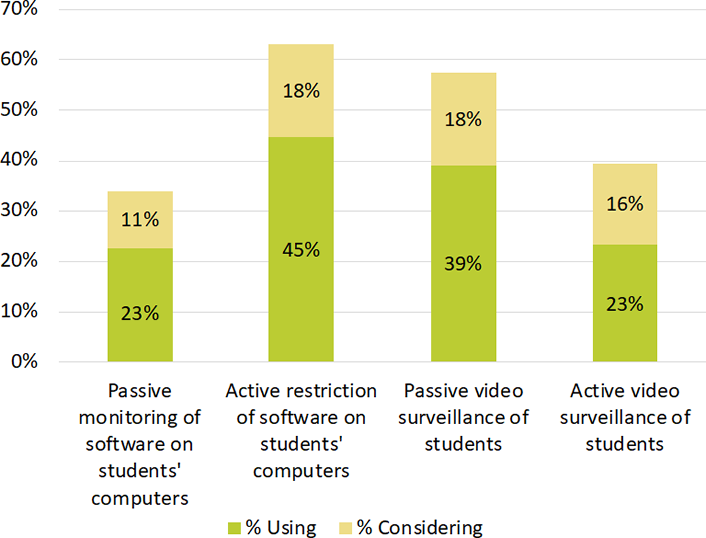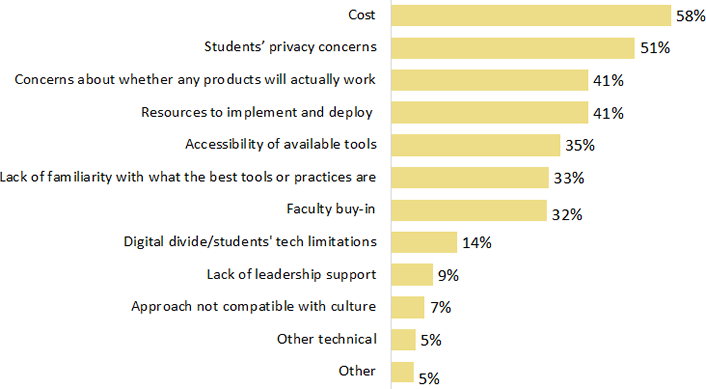With the massive and abrupt move to remote teaching and learning, higher education institutions need to address course grading and exam proctoring to maintain educational continuity.

As the COVID-19 pandemic upends higher education in 2020, institutions are relying on digital alternatives to missions, activities, and operations. Challenges abound. EDUCAUSE is helping institutional leaders, IT professionals, and other staff address their pressing challenges by sharing existing data and gathering new data from the higher education community. This report is based on an EDUCAUSE QuickPoll. QuickPolls enable us to rapidly gather, analyze, and share input from our community about specific emerging topics.1
The Challenge
Having made the initial transition to remote teaching and learning, colleges and universities are working to maintain continuity of the entire educational process. Grading courses disrupted by the pandemic and proctoring exams taken remotely present special challenges. How can institutions deter cheating on online exams? How can students perform at their usual levels when working under stressful and, for many, less-than-ideal conditions? Students without adequate bandwidth or equipment may be unfairly disadvantaged. Students with accessibility needs must be supported. How can faculty administer exams taken remotely? Many are new to remote learning. Remote assessment raises the stakes for both students and faculty.
The Bottom Line
Higher education institutions are adapting grading and assessment policies and are deploying technologies to adjust grading and proctoring to the special circumstances of the pandemic.2 Over three-quarters of institutions may use online or remote proctoring for exams. Many of their product choices meet accessibility standards, but quite a few do not.
In their haste to deploy some forms of remote proctoring, institutions are spending money they don't have to acquire products they don't fully understand. Cost and concerns about students' privacy are the most widespread challenges of adopting online proctoring solutions. Three in ten institutions are considering an alternative approach. Rather than moving traditional assessment online, they are exploring the idea of changing assessment entirely to adopt more authentic demonstrations of knowledge and skills.
The Data: Grading and Assessment
Almost all institutions are adapting course grading. Only 14% are making no changes, while 77% of institutions have made changes, and another 9% are still considering changing course grading. For those making changes, the most common change is adopting pass/fall or credit/no credit instead of grading courses (see table 1).
Table 1. Changes to Course Grading
|
Has your institution made any changes to course grading as a result of the COVID-19 pandemic? |
Percentage of institutions that have changed course grading |
|---|---|
|
Yes, we are moving to pass/fail (or similar) for all courses. |
22% |
|
Yes, we are moving to pass/fail (or similar) for some courses. |
41% |
|
Yes, we are moving to pass/fail or credit/no credit as an option for students. |
31% |
|
Yes, we are making some other change to course grading (please specify). |
6% |
Many institutions are making grading as flexible as possible. Changes include the following:
- Offering more lenient criteria for grades of incomplete
- Extending the dates for final grade submission
- Allowing for much later withdrawal from courses
- Allowing students to see their grades and then letting them decide whether the grade or a pass/fail will be recorded
- Reweighting assessment and assignment grades within a course
Three in ten institutions are considering broad changes to assessment. Exams are common, but they are only one way to assess learning. The pandemic is providing 31% of institutions the opportunity to consider more authentic demonstrations of knowledge and skills. The decision to move away from exams is commonly made by faculty rather than across the entire institution. Public master's institutions (55%) are most likely to be exploring assessment changes, and private bachelor's institutions (11%) are least likely. Changes under consideration include basing assessments on multiple methods including projects, discussions, simulations, videos, podcasts, and essays. A few institutions are opting not to make any assessments this term.
The Data: Online or Remote Proctoring
Over three-quarters of institutions may use online or remote proctoring for exams during the pandemic. Half of institutions (54%) are currently using online or remote proctoring services, and another 23% are planning or considering using them.
Online proctoring takes several forms. We asked about four types of proctoring:
- Passive monitoring of software on students' computers (by tracking application[s] students are running on their computers and whether they switch to another application while taking an exam)
- Active restriction of software on students' computers (by using a "lockdown browser" application that blocks access to other applications during exams or course activities)
- Passive video surveillance of students (by using software that accesses a student's webcam to directly monitor them)
- Active video surveillance of students (by using a method similar to passive video surveillance software but adding real-time monitoring by live proctors)3
All four types of proctoring are commonly used (see figure 1). Active restriction of software and passive video surveillance are the most widespread. Most institutions (80%) that adopt online proctoring use more than one type, and 18% use all four.

A few products dominate the market for proctoring software. Respondus products are the most widely used. Two-thirds of institutions (65%) are using the Respondus Monitor and/or LockDown Browser products (see figure 2). ProctorU is the next favored online proctoring tool, used by 23% of institutions. Some institutions are using Zoom for active video exam proctoring.

Many institutions' product choices meet their accessibility standards, but quite a few do not. Six in ten institutions reported that the online proctoring products they use meet their accessibility standards. Another 26% of institutions use some products that don't meet their accessibility standards, and 8% did no accessibility vetting at all. Some institutions with accessibility gaps noted that they provide alternatives and specific accommodations for students with accessibility issues.
Remote proctoring is difficult; most institution have multiple challenges. Cost and concerns about students' privacy are challenges for more than half of institutions (see figure 3). But additional challenges are also widespread, including accessibility issues, inexperience with remote proctoring, lack of faculty buy-in, and resource limitations. Respondents reported three challenges, on average. At least some institutions find their constituents are highly conflicted about the entire approach of remote proctoring. Many are honor code institutions, which require that all students pledge to adhere to the code and help monitor academic and sometimes social misconduct. Proctoring technologies would contravene their culture of trust. One respondent described remote proctoring as "not great pedagogy," and another described it as "legitimately evil."

Promising Practices
Proctoring goes hand-in-hand with traditional assessment. The reason so many colleges and universities are adopting remote proctoring is because so many courses rely on traditional forms of assessment. At some institutions, faculty are planning to move away from multiple-choice and similar kinds of exams. Promising practices include the following:
- Exams are either "open resource" or are assignments/projects.
- In lieu of final exams, faculty are required to offer asynchronous take-home (open-book) exams, final papers, final projects, or a series of smaller low-stakes assessments.
- Many more courses are incorporating problem-based assessments.
- Faculty are moving to project-based assessment.
- Students are participating in discussions about and demonstrations of their knowledge.
- Assessments may be project-based, discussion-based, reflective assignments, videos, or podcasts.
- We are adapting assignments based on students' resources (e.g., video presentations, handwritten papers).
- We are working to bring more simulation-based assessment online.
- Written exams are staying the same, but practicums will take place when we return to campus.
The COVID-19 pandemic is forcing higher education leaders, faculty, and staff to make difficult decisions. Online and remote academic assessments are feasible and valid, with sufficient pedagogical and technical expertise and preparation. Most institutions are changing their grading policies to account for the stress and limitations experienced by students, faculty, and staff. As is so often the case, technology is no silver bullet. Rethinking assessment entirely is the best solution. Some, but perhaps not enough, institutional leaders and faculty are taking that more difficult but also more beneficial path.
EDUCAUSE will continue to monitor higher education and technology related issues during the course of the COVID-19 pandemic. For additional resources, please visit the EDUCAUSE COVID-19 web page. All QuickPoll results can be found on the EDUCAUSE QuickPolls web page.
For more information and analysis about higher education IT research and data, please visit the EDUCAUSE Review Data Bytes blog as well as the EDUCAUSE Center for Analysis and Research.
Notes
- QuickPolls are less formal than EDUCAUSE survey research. They gather data in a single day instead of over several weeks, are distributed by EDUCAUSE staff to relevant EDUCAUSE Community Groups rather than via our enterprise survey infrastructure, and do not enable us to associate responses with specific institutions. ↩
- The poll was conducted on April 7, 2020. Respondents represented 312 institutions. The poll consisted of thirteen questions and took most respondents less than two minutes to complete. Poll invitations were sent to participants in EDUCAUSE community groups, including the CIO, Women in IT, LAT (leading academic transformation), and Community College groups. Most respondents (294) represented US institutions. Other participating countries included Australia, Canada, China (Hong Kong), Finland, Ireland, Saint Lucia, and Trinidad and Tobago. An appropriately diverse range of institution sizes and Carnegie classifications participated. ↩
- We based our definitions on D'Arcy Norman's excellent overview "Online Exam Proctoring," D'Arcy Norman dot net (blog), March 31, 2020. ↩
Susan Grajek is Vice President of Communities and Research at EDUCAUSE.
© 2020 Susan Grajek. The text of this work is licensed under a Creative Commons BY-NC-ND 4.0 International License.
